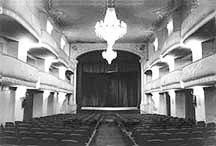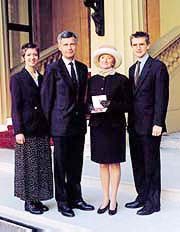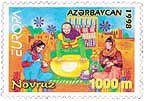|

Spring
1999 (7.1)
Pages
8-11
Reader's Forum
Baku's
Multi-Culturalism
- Vugar Seidov, Budapest,
Hungary
Baku's "ABC's"- Afagh
Mastanova (16) and Konul Khalilova (16), Baku Turkish Anatolian
High School
Noruz in Texas - Rubaba Ismayilova,
Graduate Student at Texas A&M University and recipient of
a Pennzoil Student Scholarship
Tabriz Theater - Pirouz Khanlou,
Publisher, Azerbaijan International
Theatrical Performances -
Dr. Hasan Khanlou, Tabriz (Azeri-Arabic script)
Memories of Yesteryear -
Hadi Shafaieh
Queen Recognizes Elizabeth Young,
wife of Ambassador Thomas Young
Noruz stamp designs by Ismayil
Mammad
Baku's
Multi-Culturalism
While reading newspapers,
browsing the Internet, watching TV, I often encounter materials
that are deliberately aimed at damaging the image of my home
country, Azerbaijan, in the eyes of the international community.
For those who are somewhat familiar with the post-Soviet destiny
of Azerbaijan, it is quite obvious which forces are pursuing
this goal and for what ultimate purpose. They desperately create
new myths and spread them throughout their propaganda network.
Unfortunately, ordinary people abroad know so little about Azerbaijan's
dramatic history, rich culture and beautiful traditions. Therefore,
these myths often take root and lead to negative stereotypes
about our country.
In this regard, it is important to counter the misrepresentation
of our country and nation by educating the international public
through the available media channels. One area that has recently
been targeted is Azerbaijan's treatment of its numerous ethnic
and religious minorities. For me, it is particularly disturbing
to hear about the alleged oppression of minorities in Azerbaijan,
as I come from there and know these charges are not true. Ethnic,
linguistic and religious diversity has made Baku a historical
model of a multicultural society, so much so that one of our
prominent writers, Magsud Ibrahim-beyov, is fond of saying, "It
would as hard to create an ultra-nationalist group in Baku as
it would be to form a local ice-hockey team."
Given this background, any attempt to suggest that Azerbaijan's
minorities are oppressed is absurd. In my opinion, opening a
discussion on this issue in AI would serve as a good channel
to deliver information to those who would be interested to learn
more about the diversity in Azerbaijani society.
For example, one of the most vivid manifestations of Azerbaijan's
religious tolerance can be found in the architecture of downtown
Baku where a Muslim mosque, a Jewish synagogue, and Russian Orthodox
, Protestant and Armenian church buildings are all located within
one square mile. When it comes to the Jewish community, Azerbaijan
is one of the very few places in the world where this group does
not experience anti-Semitism. A sizeable Jewish community has
lived right alongside the indigenous population for many generations.
It's interesting to note the
beginning of a trend that seems to be developing among Jews from
Azerbaijan who emigrated to Israel for economic reasons in the
early 1990s. Already a number of them have returned to Baku to
open businesses. I was surprised to meet several old friends
of mine in Baku recently who had left for Israel and who told
me that once they arrived there, they had faced severe competition
for the best jobs with other newcomers and earlier immigrants.
And so some are returning to Azerbaijan.
Unfortunately, such examples of our open-mindedness and multi-culturalism
are too frequently glossed over, leaving the negative stereotypes
of the region to influence the minds of the international community
Vugar Seidov
Budapest, Hungary
UP
Baku's
"ABC's"
We read your magazine
and like it very much not just because it gives us a chance to
improve our English skills - it's more than that. It gives us
a chance to learn more about our own country and culture. Every
time we open it we find something new.
In the last issue about Architecture, we liked the article "Just
for Kids" called "The ABC's of Baku" [AI 6.4,
pg. 66-67]. Many times we've seen those letters - those monograms
- carved on some of the old buildings but never realized that
they were the initials of the original owners. Even though we
know about the Oil Baron Haji Zeynalabdin Taghiyev, we never
realized that his initials "ZT" could be found on his
old buildings. Now when we walk the streets of Baku, we can understand
more of our history. So, thanks.
Afagh Mastanova
(16) and Konul Hilalova (16)
Baku Turkish Anatolian High School
UP

Noruz in Texas
I'm an Azeri originally
from Georgia and born in Tbilisi, so there are many things about
the history and culture of Azerbaijan that I am not familiar
with. That's why I always find something new in every issue of
your magazine.
By the way, we just celebrated Noruz (New Year-Spring Equinox,
March 21) here. There were about 15 of us from Azerbaijan in
various departments of the university. Also, we found students
from Uzbekistan and Kazakstan who also celebrate Noruz. Recently,
we all got together and had a chance to wear our national costumes
and present our national dances at the International Week at
the university. It was a nostalgic occasion for all of us right
here in Texas.
Rubaba Ismayilova
Graduate Student at Texas A&M University
and recipient of a Pennzoil Student Scholarship
UP
Tabriz
Theater
  Publisher's Note: Publisher's Note:
In our last issue, we published an article about the Tabriz Opera
Theater [See AI 6.4, pg. 68-69, "History Won't Forget"]
in Azeri (Arabic script). This building was a unique architectural
landmark built early this century. Although the architect is
unknown, he is believed to have come from the Caucasus since
he incorporated the same style that is found in so many buildings
in Baku and Tbilisi-a combination of Italian Renaissance style
with a highly ornamental interior of German Rococo.
In the mid-1970s, as an architecture student in London, I wrote
my thesis on The Qajar Period Architecture of Tabriz and took
photos, measured drawings of the building's floor plan and did
a survey of the building. Unfortunately, this building no longer
exists. To everyone's dismay, in 1980 a decision was made to
bulldoze the building and open the space for Friday prayers in
the center of Tabriz.
As far as we know, there has
never been any other documentation of significance ever published
about this building. Our article seemed to trigger a lot of bittersweet
memories, especially among Tabrizis who used to attend plays
and concerts in that elegant theater. Here are a few samples:
Pirouz Khanlou
UP
Theatrical
Performances
Your recent article
about the Tabriz theater was developed from an architectural
point of view. It would be a pity not to mention a few names
associated with the dramatic works performed there, especially
that of Mohammad Ali Roshdi and his colleagues. Roshdi was a
brilliant actor who also served as director and prompter. Under
his direction, a number of Uzeyir Hajibeyov's works were performed
there. Later, Roshdi collaborated with the gifted actor Ali Sadeghi,
Mr. Aminpoor and Fatima Zarghar. Thanks to their collaboration,
the theater became quite popular in Tabriz in the 1950s and 1960s.
Mr. Roshdi taught Acting and Theater at the Teacher's Training
College in Tabriz during the 1950s and often directed plays written
by a local writer, Mr. Hossein Omid, a high school literature
teacher. These used to be performed especially at notable events
when officials came to Tabriz.
Dr. Hasan Khanlou
Tabriz (Azeri-Arabic script)
UP
Memories
of Yesteryear
My son subscribes to
your magazine. I don't know English, but I read the Azeri articles
both in Latin and Arabic script. I look at the pictures and I
understand them very well! (I'm a professor of photography in
Iran).
Thanks for your article about the Tabriz Opera Theater in your
latest issue. Those rare photos had a deep effect on me, reminding
me of my childhood when I was four or five years old. Now 70
years later, I can still remember the plays I saw and the décor
of the theater because we used to go there quite often.
My uncle had a friend named Asadulla Khan. I don't know what
his position was, but he certainly had considerable authority.
He came from the Caucasus just as we had come from Tbilisi. He
regularly sent us tickets for seats in one of the upper booths
on the right-hand-side. You can see it in the picture. That was
our regular place.
The first booth with the light-blue velvet curtain belonged to
the Shah (the Royal Booth), though he never, ever attended! I
remember so vividly the old Azeri plays that were performed there.
Oh, those marvelous days!
Hadi Shafaieh
Tehran (Azeri-Arabic script)
UP
Queen
Recognizes Young
  It's
not every day that you get an audience with the Queen, much less
a chance to tell her about something close to your heart. Last
November, Elizabeth Young, the wife of Thomas Young, former British
Ambassador to Azerbaijan (1993-1997), was able to do just that.
Elizabeth was named Member of the Order of the British Empire
for her charitable services in Azerbaijan and received the medal
at Buckingham Palace from Queen Elizabeth herself. It's
not every day that you get an audience with the Queen, much less
a chance to tell her about something close to your heart. Last
November, Elizabeth Young, the wife of Thomas Young, former British
Ambassador to Azerbaijan (1993-1997), was able to do just that.
Elizabeth was named Member of the Order of the British Empire
for her charitable services in Azerbaijan and received the medal
at Buckingham Palace from Queen Elizabeth herself.
The two of them discussed the current situation in Azerbaijan
at length. Elizabeth recalls, "She [Her Majesty] asked me
how things were in the orphanages in Azerbaijan, and I was able
to tell her how much better off the children and care-givers
are these days than before. I accepted the prize not just for
myself but also on behalf of all the others who helped with everything
I did there. I like to think the Order also came in recognition
for all we spouses do to support our husbands during their Foreign
Service careers."
Elizabeth's husband, Thomas, was the first British Ambassador
to Azerbaijan. When they first arrived in Baku in 1993, one of
the first things that Elizabeth did was to help found the International
Women's Club of Baku (IWC) with a membership of 50% Azeri and
50% foreign women. The club's purpose is to foster friendship
and mutual understanding between foreigners and Azerbaijanis.
By 1997, when the Youngs left for a new assignment in Zambia,
the club had grown to more than 150 members.
One of the IWC's main goals is to improve the quality of life
for local handicapped children and orphans. Under the Soviet
system, the State took care of everyone with disabilities. Beginning
in the early 1990s, the conditions at most institutions worsened
considerably. Facilities were run down, and there was no money
to improve them.
The club's initial fund-raising efforts for children began with
a raffle, which raised $5,000. The next year, they raised $12,000-the
next, $20,000. Each year, events such as the Holiday Bazaar,
held each December, raise more and more money for Baku-area children.
By 1997, the total amount raised exceeded $100,000.
Most of the money is spent locally.
The IWC provides many items to local institutions, including
kitchen equipment, laundry facilities, blankets, educational
materials and toys. Club members enlist the help of the local
business community to improve the children's living conditions,
such as heating, wiring and plumbing.
One particularly large effort was a children's circus party held
in January 1997. With the cooperation and support of many companies
and organizations, the IWC brought in 2,400 children to enjoy
a day of circus performances. Elizabeth calls it "one of
the most exciting and fulfilling things I've ever done. The look
of delight on the children's faces will remain with me forever."
When the Youngs first arrived in Baku in 1993 and set up the
Embassy office in the Old Intourist Hotel, they comprised nearly
30 percent of the total British population in Baku-two out of
a total of seven British expatriates. Today there are thousands.
The younger Young generation has also built up relationships
with Azerbaijan. Their daughter Harriet, upon graduating from
Oxford, came to Baku for 15 months and worked for UNHCR, World
Bank, UNICEF and Save the Children. She and her parents served
as UN monitors for the 1995 elections. The Young's son Simon
visited Baku regularly during his breaks from university. The
Youngs hope to visit friends in Baku this summer and also to
see how the children in the orphanages are getting along.
UP
From Azerbaijan International (7.1) Spring 1999.
© Azerbaijan International 1999. All rights reserved.
Back to Index
AI 7.1 (Spring 99)
AI Home
| Magazine
Choice | Topics
| Store
| Contact
us
|





